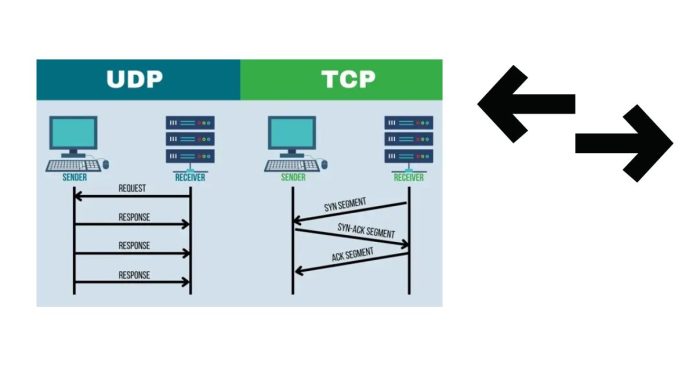TCP (Transmission Control Protocol) and UDP (User Datagram Protocol) are the two primary transport layer protocols in the Internet Protocol (IP) suite. They are used for sending data over a network but differ significantly in functionality and use cases.
Key Differences
| Feature | TCP (Transmission Control Protocol) | UDP (User Datagram Protocol) |
|---|---|---|
| Connection Type | Connection-oriented: Requires a handshake before communication begins. | Connectionless: No handshake or setup phase is required. |
| Reliability | Reliable: Ensures all data packets are delivered in the correct order. | Unreliable: Does not guarantee delivery or order. |
| Data Delivery | Provides error checking, retransmission, and acknowledgment mechanisms. | Provides basic error checking with no retransmissions. |
| Speed | Slower due to overhead for reliability. | Faster because it has minimal overhead. |
| Packet Order | Ensures packets are received in order. | Does not ensure packet order; packets may arrive out of sequence. |
| Overhead | Higher overhead due to additional features like acknowledgment. | Lower overhead, making it lightweight. |
| Header Size | Larger (20 bytes) due to features like sequence numbers and acknowledgments. | Smaller (8 bytes), as it only includes essential information. |
| Use Cases | Applications needing reliability (e.g., file transfers, emails). | Applications needing speed and low latency (e.g., video streaming, gaming). |
| Flow Control | Yes, TCP uses flow control mechanisms to prevent data overflow. | No flow control; data is sent as quickly as possible. |
| Congestion Control | Yes, TCP uses congestion control to manage network traffic. | No congestion control. |
When to Use TCP
TCP is suitable for applications where data accuracy and reliability are critical. Examples include:
- Web browsing (HTTP/HTTPS)
- Email (SMTP, IMAP, POP)
- File transfers (FTP)
- Remote access (SSH, Telnet)
When to Use UDP
UDP is ideal for applications that prioritize speed and low latency over reliability. Examples include:
- Streaming services (Netflix, YouTube)
- Online gaming
- Voice over IP (VoIP) (Skype, Zoom)
- DNS lookups
Summary
- TCP: Reliable, ordered, and connection-oriented, suitable for tasks requiring accuracy.
- UDP: Fast, connectionless, and lightweight, best for real-time applications where speed matters more than reliability.
Both protocols serve distinct purposes and are chosen based on the requirements of the application.


